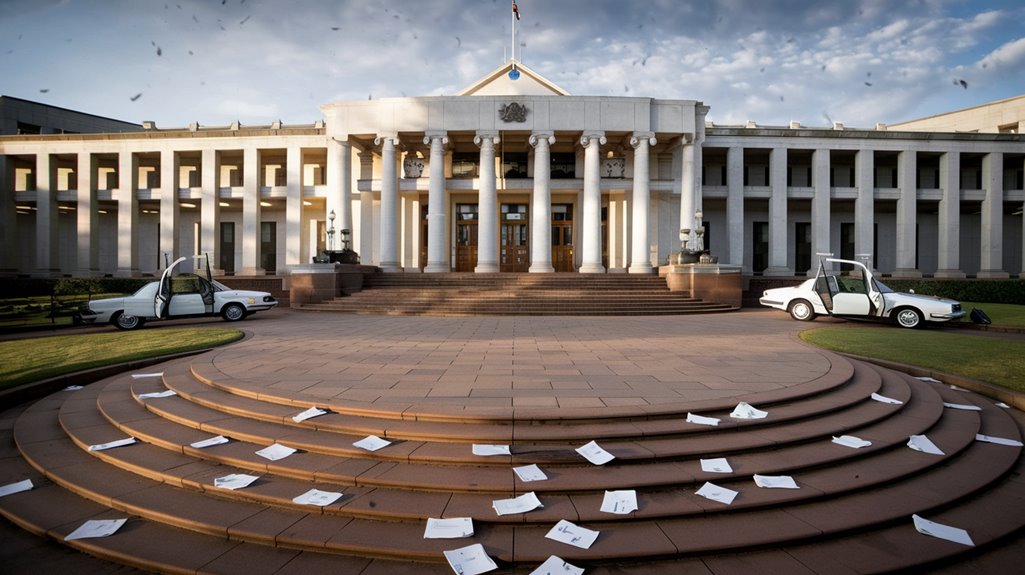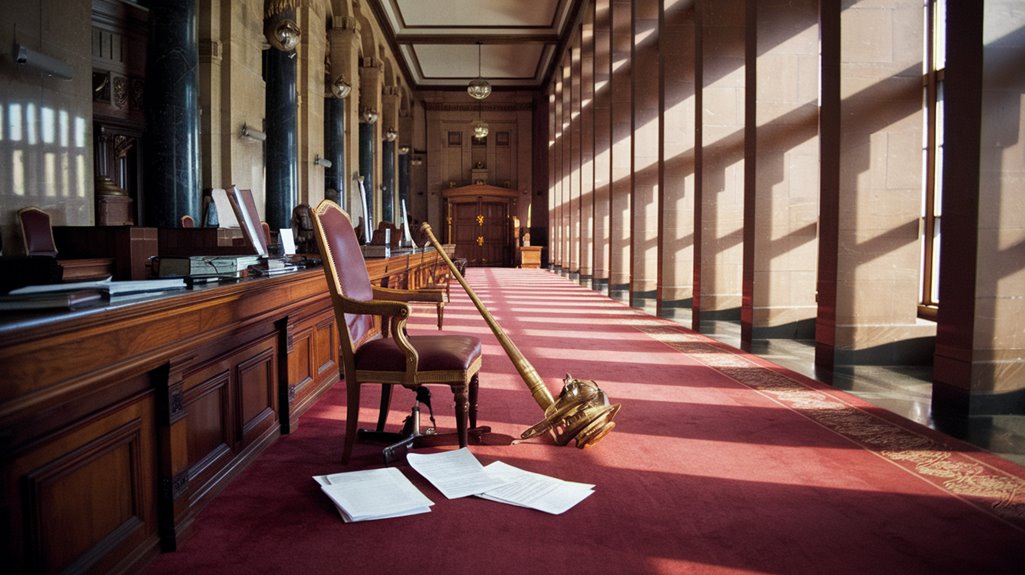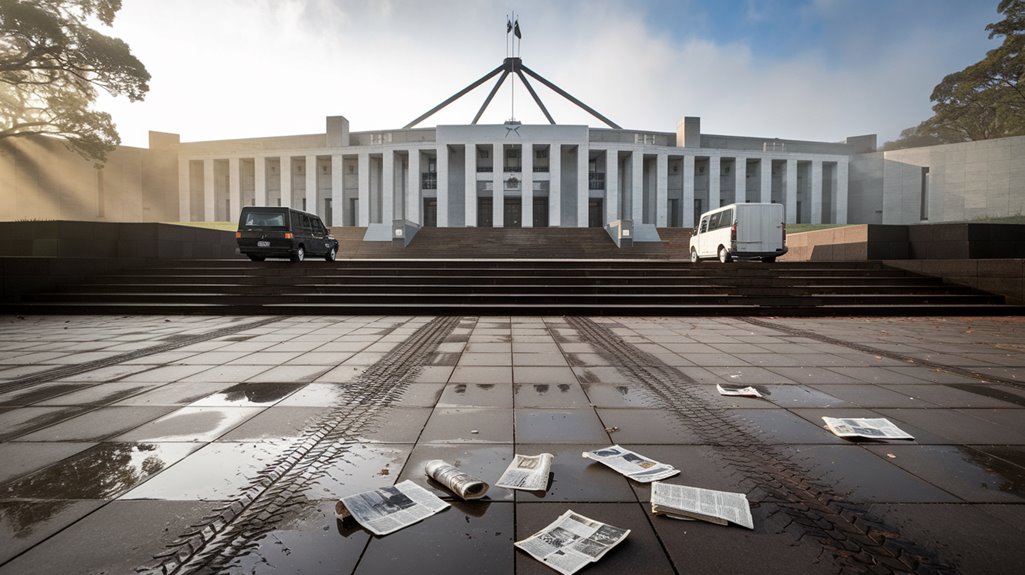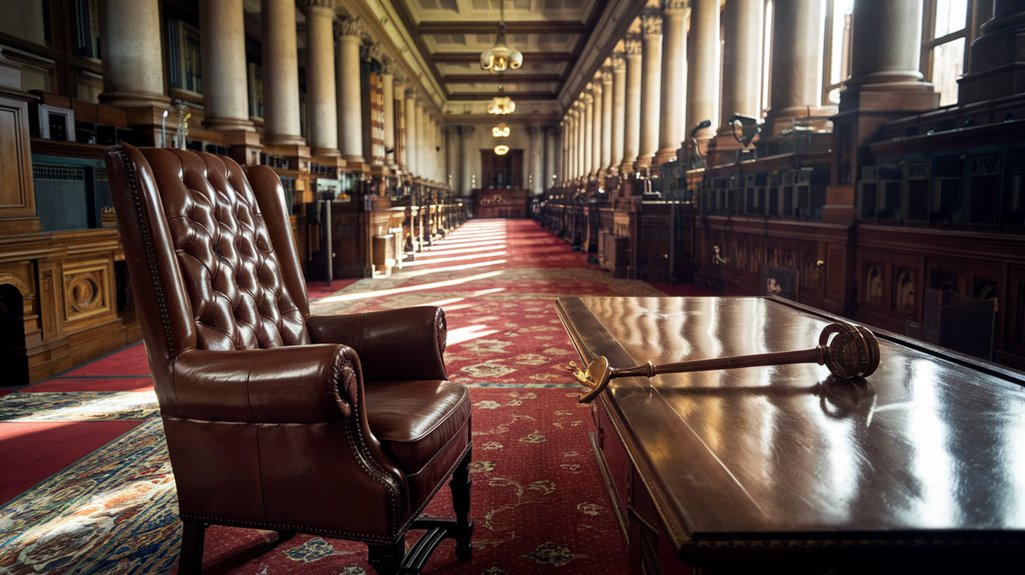The Australian Government Was Entirely Dismissed in 1975
Like a crack of thunder on a clear day, Australia's 1975 Constitutional Crisis shook the nation's democratic foundations to their core. You've probably heard whispers of this remarkable moment when Governor-General Sir John Kerr dismissed Prime Minister Gough Whitlam's entire government. It's the kind of political drama that makes you question everything you thought you knew about democratic systems. As you consider the events of November 11, 1975, you'll discover why Australians still debate the legitimacy of this unprecedented power play.
The Political Landscape Leading to the Constitutional Crisis

While Australia's parliamentary system had generally functioned smoothly since federation, 1975 marked an unprecedented constitutional crisis that began with a stark political deadlock.
You'll find that political polarization intensified when the Opposition-controlled Senate refused to pass essential budget bills, particularly the Supply Bills needed to fund government operations.
The governance challenges became evident as both sides held firm to their positions – the government insisted on its right to rule with its House of Representatives majority, while the Opposition maintained that failing to secure Supply should trigger resignation.
Malcolm Fraser's Liberal-Country Coalition demanded a fresh election in exchange for passing the budget bills through the Senate.
Australia's bicameral system, with its House and Senate structure, played a crucial role in the unfolding crisis.
The situation highlighted deep disagreements over constitutional conventions, especially regarding the balance of power between the House of Representatives and Senate.
These fundamental disputes about Australia's democratic processes would eventually lead to one of the nation's most significant political confrontations.
Key Players in Australia's Most Dramatic Political Event
The dramatic events of 1975 centered on five key figures who'd shape Australia's most significant constitutional crisis. At the heart of the conflict were Governor-General Sir John Kerr and Prime Minister Gough Whitlam.
While Kerr's motivations included restoring political stability, he controversially kept his plans hidden from Whitlam. Meanwhile, Whitlam's strategies focused on breaking Opposition Leader Malcolm Fraser's Senate blockade. The crisis intensified when Senate vacancy filling shifted power to the opposition.
Two influential legal minds played vital behind-the-scenes roles. Chief Justice Sir Garfield Barwick provided Kerr with formal legal advice, while High Court Judge Sir Anthony Mason secretly helped draft the dismissal letter. This period sparked intense speculation about CIA covert operations during the crisis.
Their involvement would later raise questions about judicial independence. After Whitlam's removal, Fraser stepped in as caretaker Prime Minister and went on to win the subsequent election with a decisive majority.
The Controversial Senate Blockade and Supply Crisis
In late 1974, Australia's Senate sparked an unprecedented constitutional crisis by blocking essential appropriation bills needed to fund government operations.
Under Malcolm Fraser's leadership, the opposition's Senate tactics involved rejecting 21 government bills, effectively threatening to cut off government funding unless Prime Minister Whitlam called a new election.
You'll find this deadlock created a dangerous situation where the government risked being unable to pay its employees or maintain essential services.
The Senate's power to block supply bills meant they could effectively force the government's hand, despite not having the constitutional authority to remove a prime minister directly.
This three-week standoff highlighted the significant power struggle between Australia's upper and lower houses, ultimately leading to one of the most controversial moments in the nation's political history.
November 11: The Day Democracy Was Tested
As tensions reached their peak over the supply crisis, November 11, 1975, became etched in Australian history as the day that shook the nation's democratic foundations.
With democracy under siege, Governor-General Sir John Kerr made the unprecedented decision to dismiss Prime Minister Gough Whitlam at 1:00 pm, sparking immediate nationwide protests and raising questions about political accountability.
Here's what unfolded on that momentous day:
- Whitlam sought Kerr's approval for a half-Senate election to break the deadlock.
- Kerr dismissed Whitlam and appointed Malcolm Fraser as caretaker PM.
- Fraser quickly passed the blocked supply bills.
- The Speaker, Gordon Scholes, wrote to the Queen seeking Whitlam's reinstatement.
The crisis tested Australia's constitutional framework, leading to the largest political demonstrations in the nation's history and forever changing how Australians viewed their democratic institutions.
The Lasting Impact on Australian Politics and Society

While decades have passed since the 1975 constitutional crisis, its ripple effects continue to shape Australia's political landscape and democratic institutions.
You'll find that this watershed moment not only tested political trust but also led to significant constitutional changes, including reforms to Senate casual vacancy procedures in 1977.
The Whitlam reforms left an enduring legacy despite the controversial dismissal. The appointment of the Governor-General, Sir John Kerr, led to massive Senate blockages that ultimately threatened the government's stability.
You can see their impact in the Order of Australia, support for Indigenous rights, and cultural initiatives through the Australian Film Commission.
However, the crisis exposed vulnerabilities in Australia's constitutional framework, creating deep societal divisions that sparked ongoing debates about democratic governance.
While the Liberal-Country Coalition secured a decisive victory in the subsequent election, the dismissal's aftermath has made Australians more vigilant about constitutional clarity and political stability.










